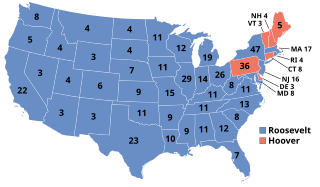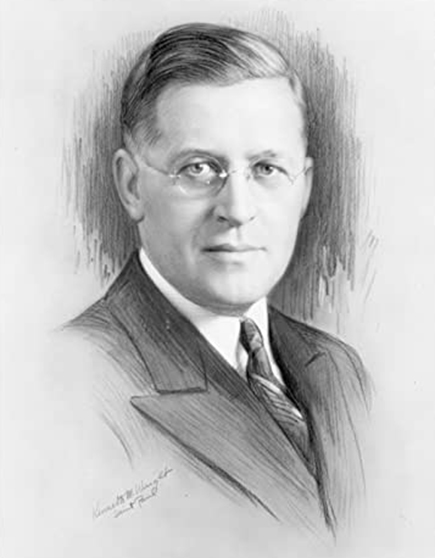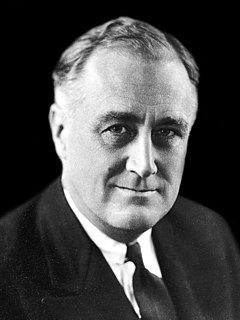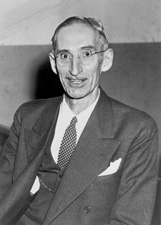Notes
| Recognized major parties | |
|---|---|
| Recognized minor parties | |
| Other minor parties | |
| Historical parties | |
| General | |
|---|---|
| National libraries | |
| Other | |
Minnesota Democratic Party | |
|---|---|
| Founded | 1849 |
| Dissolved | 1944 |
| Merged into | Minnesota Democratic-Farmer-Labor Party |
| National affiliation | Democratic Party |
| Colors | Blue |
The Minnesota Democratic Party was a political party in Minnesota that existed from the formation of Minnesota Territory in 1849 until 1944, when the party merged with the Minnesota Farmer-Labor Party to form the modern Minnesota Democratic-Farmer-Labor Party.
In the first two years after Minnesota's admission into the Union in 1858, the Minnesota Democratic Party was briefly the dominant party in the state; however, the 1860 presidential election and the Civil War dealt a devastating blow to the party from which it never really recovered. Between 1860 and 1918, the Minnesota Democratic Party was a distant second party to the dominant Republican Party. During that period, Democrats held the office of Governor of Minnesota for a grand total of seven years, never controlled either chamber of the Minnesota Legislature, and Minnesota never cast a single electoral vote in favor of a Democratic presidential nominee.
Following the establishment of the Farmer-Labor Party in 1918, the Minnesota Democratic Party was relegated to third party status, as the Farmer-Laborites became the primary opposition to the Republicans. During the 1930s, a political alliance between Minnesota Governor Floyd B. Olson and President Franklin D. Roosevelt bred closer cooperation between the Farmer-Laborites and the Democrats. With a large backing from Farmer-Laborites, Roosevelt became the first Democrat ever to win Minnesota's electoral votes in 1932, and went on to win the state in each of his re-election bids. In the 1936 gubernatorial election the Democratic Party opted not to run its own candidate for Governor, endorsing Farmer-Labor candidate Elmer Austin Benson instead.
After the Farmer-Laborites' spectacular fall from power in the 1938 general election, there was increasing pressure from the national Democratic Party for a merger between the Minnesota Democratic Party and the Farmer-Labor Party. In spite of substantial minorities in both parties continuing to oppose merging, the majority in the Farmer-Labor Party led by former-Governor Benson and the slim majority of the Minnesota Democratic Party led by future-Vice President Hubert H. Humphrey ultimately concluded such a merger in 1944, creating the Minnesota Democratic-Farmer-Labor Party.

The 1932 United States presidential election was the 37th quadrennial presidential election, held on Tuesday, November 8, 1932. The election took place against the backdrop of the Great Depression. Incumbent Republican President Herbert Hoover was defeated in a landslide by Democrat Franklin D. Roosevelt, the Governor of New York and the vice presidential nominee of the 1920 presidential election. Roosevelt was the first Democrat in 80 years to win an outright majority in the popular and electoral votes, the last one being Franklin Pierce in 1852. Hoover was the last elected incumbent president to lose reelection until Jimmy Carter lost 48 years later. The election marked the effective end of the Fourth Party System, which had been dominated by Republicans.
Electoral fusion is an arrangement where two or more political parties on a ballot list the same candidate, pooling the votes for that candidate. It is distinct from the process of electoral alliances in that the political parties remain separately listed on the ballot. The practice of electoral fusion in jurisdictions where it exists allows minor parties to influence election results and policy by offering to endorse or nominate a major party's candidate.

The Minnesota Democratic–Farmer–Labor Party (DFL) is a major political party in the U.S. state of Minnesota. The party’s platform is described as moderate. The DFL, due to its historically blue-collar base, has a long history of having support in both rural and urban parts of Minnesota. Some of the party’s main focuses are economic growth, environmental protection, education, and government accountability. It was formed by a merger between the Minnesota Democratic Party and the Minnesota Farmer–Labor Party in 1944.

Elmer Austin Benson was an American lawyer and politician from Minnesota. In 1935, Benson was appointed to the U.S. Senate following the death of Thomas Schall. He served as the 24th governor of Minnesota, defeating Republican Martin Nelson in a landslide in Minnesota's 1936 gubernatorial election. He lost the governorship two years later to Republican Harold Stassen in the 1938 gubernatorial election.

The Minnesota Farmer–Labor Party (FL) was a left-wing American political party in Minnesota between 1918 and 1944. Largely dominating Minnesota politics during the Great Depression, it was one of the most successful statewide third party movements in United States history and the longest-lasting affiliate of the national Farmer–Labor movement. At its height in the 1920s and 1930s, party members included three Minnesota governors, four United States senators, eight United States representatives and a majority in the Minnesota legislature.

The Republican Party of Minnesota is the oldest active political party in the U.S. state of Minnesota. The Minnesota Republican Party’s platform is relatively moderate. The party’s main issues are economic growth, education, healthcare, civil rights, public safety, and environmental protection. It has a strong voter base in rural and suburban parts of Minnesota. It is the state affiliate of the Republican Party.

The United States Senate elections of 1940 coincided with the election of Franklin D. Roosevelt to his third term as President.

The United States Senate elections of 1936 coincided with the reelection of President Franklin D. Roosevelt. The Great Depression continued and voters backed progressive candidates favoring Roosevelt's New Deal in races across the country. The Democrats gained 5 net seats during the election, and in combination with Democratic and Farmer–Labor interim appointments and the defection of George W. Norris from the Republican Party to become independent, the Republicans were reduced to 16 seats, the most lopsided Senate since Reconstruction.

Minnesota is known for a politically active citizenry, with populism being a longstanding force among the state's political parties. Minnesota has consistently high voter turnout; in the 2008 U.S. presidential election, 77.8% of eligible Minnesotans voted – the highest percentage of any U.S. state or territory – versus the national average of 61.7%. This was due in part to its same day voter registration laws; previously unregistered voters can register on election day, at their polls, with evidence of residency.
The following table indicates the party of elected officials in the U.S. state of Minnesota:

The 1936 Minnesota gubernatorial election took place on November 3, 1936. Farmer–Labor Party candidate Elmer Austin Benson defeated Republican Party of Minnesota challenger Martin A. Nelson. The Democrats did not field a candidate. Magnus Johnson unsuccessfully ran for the Farmer-Labor nomination.

The 1920 Minnesota gubernatorial election took place on November 2, 1920. Republican Party of Minnesota candidate J. A. O. Preus defeated Independent challenger's Henrik Shipstead and the Mayor of St. Paul, Laurence C. Hodgson. Shipstead narrowly lost to Preus in the Republican primary of that year and challenged him in the general, beating the Democratic nominee but coming far short of winning the general.

The 1912 Minnesota gubernatorial election took place on November 5, 1912. Republican Party of Minnesota candidate Adolph Olson Eberhart defeated Democratic Party of Minnesota challenger Peter M. Ringdal.

The 2014 Minnesota gubernatorial election took place on November 4, 2014, to elect the governor of Minnesota concurrently with the election to Minnesota's Class II U.S. Senate seat, as well as other elections to the United States Senate in other states and elections to the United States House of Representatives and various state and local elections.

The 1932 United States presidential election in Wisconsin was held on November 8, 1932 as part of the 1932 United States presidential election. State voters chose 12 electors to the Electoral College, who voted for president and vice president.

The 1936 United States presidential election in Wisconsin was held on November 3, 1936 as part of the 1936 United States presidential election. State voters chose 12 electors to the Electoral College, who voted for president and vice president.

The 1932 United States presidential election in Minnesota took place on November 8, 1932 as part of the 1932 United States presidential election. Voters chose 11 electors, or representatives to the Electoral College, who voted for president and vice president.

The 1936 United States Senate special election in Minnesota took place on November 3, 1936. The election was held to fill the vacancy in the seat formerly held by Thomas D. Schall for the final two months of Schall's unexpired term. Governor Floyd B. Olson had appointed Elmer Benson to fill the seat in 1935, but this appointment was temporary and subject to a special election held in the next general election year thereafter—1936. Benson opted to run for governor instead of running for election to continue for the remainder of the term. No special primaries were held for the special election, and No special primaries were held for the special election, among Minnesota's three major parties, only the Republican Party of Minnesota officially fielded a candidate—Guy V. Howard. Regardless of the absence of Farmer-Labor and Democratic nominees, Howard nevertheless faced a great degree of competition from independent candidates Nathaniel J. Holmberg, Andrew Olaf Devold, and John G. Alexander.

The 1936 United States Senate election in Minnesota took place on November 3, 1936. Incumbent Farmer–Laborite Elmer A. Benson, who had been temporarily appointed by Governor Floyd B. Olson in 1935 to fill the seat of the deceased Republican U.S. Senator Thomas D. Schall, opted to run for Governor rather than seek election to a full term or to fill the remainder of the unexpired term. Governor Olson won the Farmer–Labor primary for nomination to the full Senate term, but died of stomach cancer prior to the general election. In Olson's place, the Farmer–Labor Party ran U.S. Representative Ernest Lundeen, who went on to defeat former Governor Theodore Christianson of the Republican Party of Minnesota in the general election. A special election held on the same date elected Republican nominee Guy V. Howard to serve the remainder of Schall's unexpired term.

The 1940 United States Senate election in Minnesota took place on November 5, 1940. Incumbent U.S. Senator Henrik Shipstead defected to the Republican Party of Minnesota from the Farmer–Labor Party of Minnesota, and defeated former Governor Elmer Benson of the Farmer–Labor Party and John E. Regan of the Minnesota Democratic Party to win a fourth term.